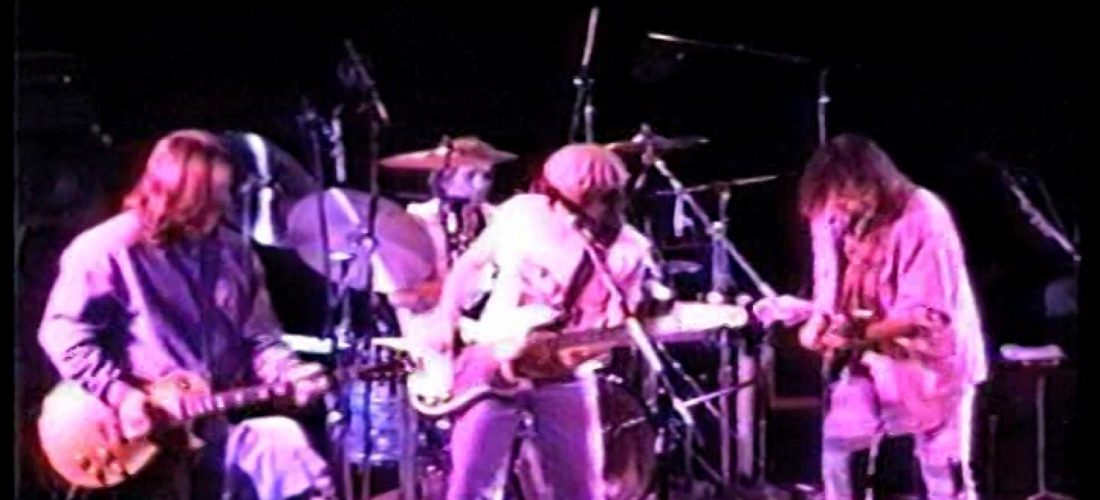‘Way Down in the Rust Bucket’ Is the Sound of Neil Young and Crazy Horse Getting Reinvigorated for the Nineties
Between vintage concert albums and recent ones excavated from archival tapes, it’s become easier than ever to track the onstage history of Neil Young and Crazy Horse. We can now hear Young and the band in its early, funky, Danny Whitten days (Live at the Fillmore East), breaking in Whitten replacement Frank “Poncho” Sampedro (the often breathtaking Japanese 1976 show included on last year’s Archives Volume II), thundering in arenas not long after that (Live Rust), flexing their newly revitalized muscles in the early Nineties (Weld), and showing the flannel-shirt crowd a thing or two about endurance and longevity in the mid Nineties (Year of the Horse).
Next to those projects, Way Down in the Rust Bucket isn’t especially revelatory, nor does it shed new rays of gleaming light on an under-documented part of the saga. To warm up for the 1991 arena tour heard on Weld and its noise-mayhem sibling Arc, the band played two club shows in Northern California, and this long-bootlegged tape, from the 800-seat Catalyst in the fall of 1990, documents one of them. (Young must have a fondness for that venue, since he had also played there, somewhat incognito with the Ducks, over a decade before.)
As on Weld, Way Down in the Rust Bucket showcases a reconvened band that sounds newly motivated after increasingly sluggish and creaky shows in the Eighties. They’re not yet the smooth-galloping machine they would become on the full-blown tour, though. What we’re hearing is the musicians feeling their way — for only the second time onstage — through the new material from the just-out Ragged Glory. The must-plays, like “Cinnamon Girl,” get by through sheer musical memory. But a certain tentativeness is evident on Glory songs like “Fuckin’ Up” and “Mansion on the Hill,” which would tighten up on the road; “Farmer John” sounds especially, shall we say, liquored up.
One would be hard-pressed to call any Crazy Horse show carefree, but the inclusion of goofy throwaways like “Homegrown” and “Roll Another Number for the Road” adds to the somewhat lighter vibe here. In the accompanying DVD, Billy Talbot seems especially stoked to be back on any type of stage, and as the band sets up for “Like a Hurricane,” Young takes a swig of water and drolly mentions the “big production number” coming up. At that point, the Gulf War that would hover over the “Smell the Horse” tour hadn’t begun, so don’t expect to hear the cover of “Blowin’ in the Wind,” complete with siren and gunfire sounds, that entered the set of the arena shows.
Unlike, say, Bob Dylan, Young rarely if ever dramatically rearranged his material when he played with the Horse, so major surprises here are rare. Apart from being a more sonically intimate recording than Weld, what distinguishes Rust Bucket is the set list. As if they knew they’d be playing to rabid Neil-Heads and not people who wandered into arenas expecting “Heart of Gold” and “Hey Hey, My My (Into the Black),” Young and the Horse get to roam around a bit more in his catalog.
In particular, we get to hear three deep cuts that never made it to the subsequent tour. Without the combined vocal firepower of Linda Ronstadt and Nicolette Larson, “Bite the Bullet” isn’t quite the hurricane it was on American Stars ‘N Bars, but it’s a kick to hear the Horse play it. For this show only, they also resurrected Re-ac-tor’s “T-Bone” and “Surfer Joe and Moe the Sleaze.” The former, a proud caveman’s ode to slabbed meat , has not aged especially well; actually, it wasn’t even that good on Re-ac-tor. But the fact that Young would resurrect “Surfer Joe” is amusing: Since he’d recently returned to Warner Brothers Records after a stint with Geffen, playing a song that took at dig at his old Warner bosses Joe Smith and Mo Ostin was some hippie chutzpah.
And finally, there’s Zuma‘s “Danger Bird,” which made its way-belated stage debut that night at the Catalyst (and was never played during the “Smell the Horse” shows). You wonder why it took so long for them to work it up, but it’s worth the wait. From Talbot’s spare opening notes to Young’s inevitable guitar spasms, complete with bended torso and flying hair, it’s deep-cut heaven, and reason enough for this album to exist. It’s also an indication of the serious business to come just a few months down the road.
[Find the ‘Way Down in the Rust Bucket’ Deluxe Edition Here]
